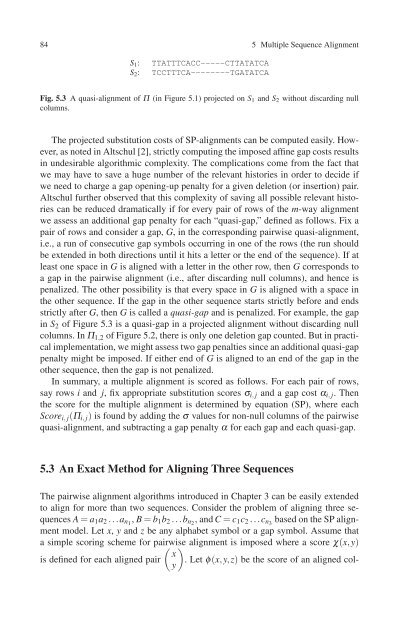You also want an ePaper? Increase the reach of your titles
YUMPU automatically turns print PDFs into web optimized ePapers that Google loves.
84 5 Multiple <strong>Sequence</strong> Alignment<br />
S 1 :<br />
S 2 :<br />
TTATTTCACC-----CTTATATCA<br />
TCCTTTCA--------TGATATCA<br />
Fig. 5.3 A quasi-alignment of Π (in Figure 5.1) projected on S 1 and S 2 without discarding null<br />
columns.<br />
The projected substitution costs of SP-alignments can be computed easily. However,<br />
as noted in Altschul [2], strictly computing the imposed affine gap costs results<br />
in undesirable algorithmic complexity. The complications come from the fact that<br />
we may have to save a huge number of the relevant histories in order to decide if<br />
we need to charge a gap opening-up penalty for a given deletion (or insertion) pair.<br />
Altschul further observed that this complexity of saving all possible relevant histories<br />
can be reduced dramatically if for every pair of rows of the m-way alignment<br />
we assess an additional gap penalty for each “quasi-gap,” defined as follows. Fix a<br />
pair of rows and consider a gap, G, in the corresponding pairwise quasi-alignment,<br />
i.e., a run of consecutive gap symbols occurring in one of the rows (the run should<br />
be extended in both directions until it hits a letter or the end of the sequence). If at<br />
least one space in G is aligned with a letter in the other row, then G corresponds to<br />
a gap in the pairwise alignment (i.e., after discarding null columns), and hence is<br />
penalized. The other possibility is that every space in G is aligned with a space in<br />
the other sequence. If the gap in the other sequence starts strictly before and ends<br />
strictly after G, then G is called a quasi-gap and is penalized. For example, the gap<br />
in S 2 of Figure 5.3 is a quasi-gap in a projected alignment without discarding null<br />
columns. In Π 1,2 of Figure 5.2, there is only one deletion gap counted. But in practical<br />
implementation, we might assess two gap penalties since an additional quasi-gap<br />
penalty might be imposed. If either end of G is aligned to an end of the gap in the<br />
other sequence, then the gap is not penalized.<br />
In summary, a multiple alignment is scored as follows. For each pair of rows,<br />
say rows i and j, fix appropriate substitution scores σ i, j and a gap cost α i, j . Then<br />
the score for the multiple alignment is determined by equation (SP), where each<br />
Score i, j (Π i, j ) is found by adding the σ values for non-null columns of the pairwise<br />
quasi-alignment, and subtracting a gap penalty α for each gap and each quasi-gap.<br />
5.3 An Exact Method for Aligning Three <strong>Sequence</strong>s<br />
The pairwise alignment algorithms introduced in Chapter 3 can be easily extended<br />
to align for more than two sequences. Consider the problem of aligning three sequences<br />
A = a 1 a 2 ...a n1 , B = b 1 b 2 ...b n2 , and C = c 1 c 2 ...c n3 based on the SP alignment<br />
model. Let x, y and z be any alphabet symbol or a gap symbol. Assume that<br />
a simple scoring scheme for pairwise ( ) alignment is imposed where a score χ(x,y)<br />
x<br />
is defined for each aligned pair .Letφ(x,y,z) be the score of an aligned col-<br />
y

















